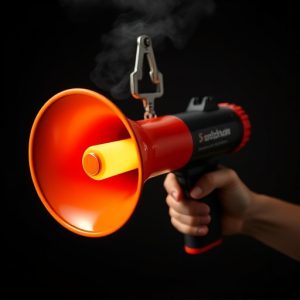Maximizing Personal Safety with Air Horn Self-Defense: A Comprehensive Guide
Air horns serve as highly effective non-lethal self-defense tools, capable of emitting a deafening …….
Air horns serve as highly effective non-lethal self-defense tools, capable of emitting a deafening sound exceeding 120 decibels to disrupt and deter potential attackers. The intense alarm not only disorients assailants but also signals for help, giving users a crucial advantage in escape or summoning assistance. Unlike weapons requiring physical strength or specialized training, air horns are accessible and legal for self-defense without the need for permits or extensive practice. For optimal effectiveness, it's important to have the air horn readily accessible, fully charged, and to be familiar with its use under stress. Directing the sound towards the ground can increase its range and impact, while environmental factors should be considered to maximize performance. When choosing an air horn for self-defense, look for the highest decibel rating available, along with optional strobe lights. Regular maintenance is essential, and in a self-defense situation, combining the use of the air horn with vocal cries for help can further improve safety outcomes. Remember to be well-informed about local laws regarding the use of air horns in public or private spaces to ensure legal compliance during an incident.
When it comes to personal safety, proactive measures can be as effective as reactive ones. In an era where self-defense extends beyond physical prowess, the air horn emerges as a critical tool for deterrence and alerting bystanders or authorities. This article delves into the transformative role of air horns in self-defense scenarios, exploring their mechanics, effectiveness, and practical use. Understanding ‘air horn self defense’ goes beyond the device’s loud sound; it’s about knowing when and how to use it effectively. Prepare to navigate the nuances of this powerful safety tool and learn how it can be a game-changer in personal security situations.
Understanding Air Horns as a Safety Tool in Self-Defense Scenarios
Air horns, often recognized for their penetrating sound capable of reaching over 120 decibels, have emerged as a highly effective self-defense tool. Unlike traditional alarms, air horns are designed to be both audibly and psychologically disorienting to potential threats, serving as a potent deterrent against personal attacks or intrusions. The shrill alarm emitted by an air horn can disrupt an assailant’s focus, creating confusion and buying the user valuable time to escape or alert authorities. The effectiveness of an air horn in self-defense scenarios lies not only in its volume but also in its ease of use; it requires no physical strength or specialized training, making it accessible to individuals across various demographics. Additionally, the non-lethal nature of an air horn ensures that it can be employed without causing permanent harm, aligning with the ethical considerations for personal safety devices. Users of air horns for self-defense should familiarize themselves with local laws and regulations to ensure compliance and proper use in public or private spaces. Understanding the role of air horns as a non-violent yet formidable self-defense tool can provide peace of mind and an additional layer of security in potentially threatening situations.
The Mechanics and Effectiveness of Air Horns for Personal Security
Air horns, a form of acoustic deterrent devices, have gained prominence in personal security arsenals due to their sheer volume and disorienting sound. When activated, an air horn emits a high-decibel alarm that can effectively attract attention and disorient potential threats, providing a critical moment for the user to escape or alert others. The mechanics behind an air horn are relatively straightforward; it utilizes compressed air to force a metered amount of sound through a small outlet, producing a loud siren. This process is initiated by pressing a trigger or button, which allows for quick and easy deployment in emergent situations.
The effectiveness of air horns as a self-defense tool lies in their audibility and the element of surprise. With decibel levels rivaling those of emergency vehicles, an air horn can cut through ambient noise and reach distances up to 100 yards or more, ensuring that it will be heard by bystanders who can come to one’s aid. The disorienting effect of the sound can incapacitate an assailant temporarily, providing a window of opportunity for escape. Moreover, air horn self-defense devices are typically legal to carry and do not require training or permits like firearms or other weapons. Their non-lethal nature also means they can be used without causing serious harm, making them a reliable option for enhancing personal safety in a variety of settings.
Practical Tips and Considerations for Using an Air Horn in Self-Defense Situations
In the event of a self-defense situation, an air horn can serve as a highly effective deterrent. Its piercing sound can disorient an attacker, potentially giving you the precious time needed to escape or alert others to your predicament. To maximize its effectiveness in such scenarios, ensure that you have the air horn readily accessible and that it is fully charged or equipped with fresh batteries. Practice deploying it so that under stress, you can activate it quickly without fumbling. Aim the horn towards the ground slightly to direct the sound upward; this approach is more effective as it carries further and reaches potential bystanders who might come to your aid. If you’re in a confined space, be mindful of how sound waves behave in such environments; a few test runs can help you understand the optimal placement for the horn within that area. Remember, the louder and more unexpected the air horn blast, the more likely it is to startle or intimidate an aggressor, thereby reducing the likelihood of physical harm. Always consider your environment when using an air horn for self-defense; its impact will vary depending on factors like weather conditions and proximity to walls or other obstacles that could diffract the sound wave.
When purchasing an air horn for self-defense purposes, look for models with the highest decibel rating possible to ensure maximum audibility. Additionally, some air horns come with added features such as built-in strobe lights which can further disorient an attacker and improve your chances of escape. It’s also beneficial to choose a model that is small enough to carry on your person without being conspicuous. Regular maintenance checks are crucial to ensure the air horn is in optimal working condition, so make it a habit to inspect it after each use and before any outings. In the unfortunate event that you find yourself in need of using your air horn for self-defense, remember to yell or call for help along with activating the device; this can significantly increase your safety and the chances of being rescued.


